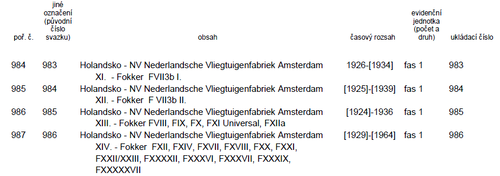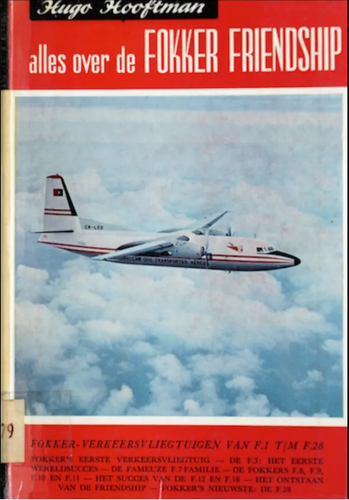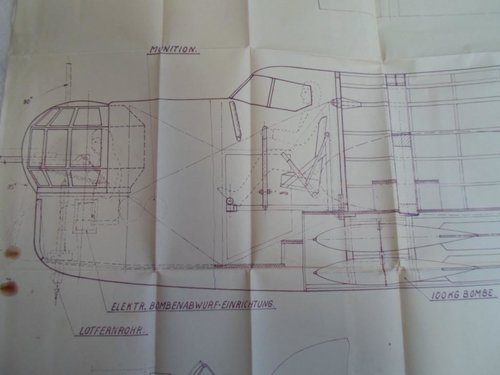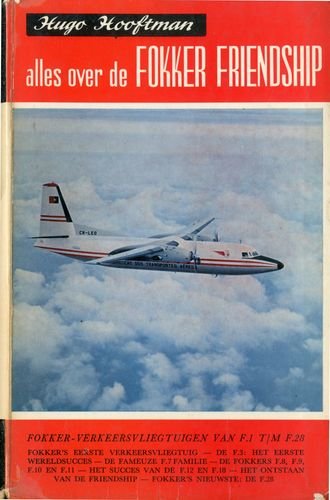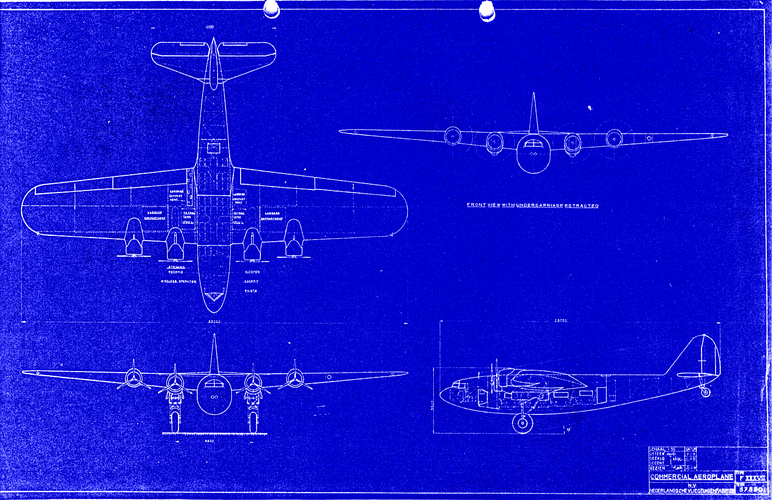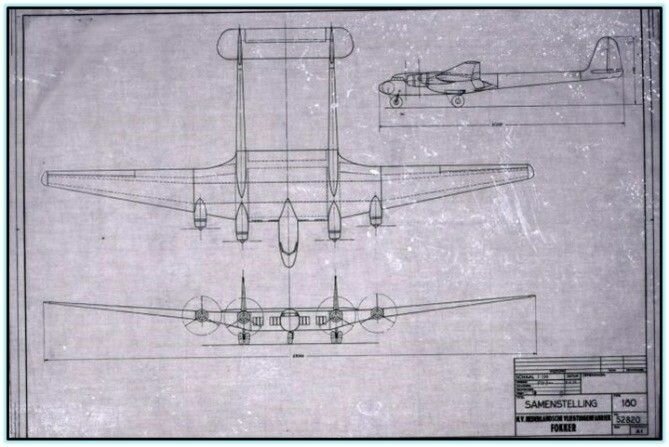You are using an out of date browser. It may not display this or other websites correctly.
You should upgrade or use an alternative browser.
You should upgrade or use an alternative browser.
Fokker Civil Projects
- Thread starter hesham
- Start date
- Joined
- 25 July 2007
- Messages
- 4,299
- Reaction score
- 4,197
I found those unknown Projects for Fokker,F.XXXIX,F.XXXXII & F.XXXXXVII,or F.39,
F.42 & F.57,does anyone hear about them ?.
They likely never existed as pre-1945 designs. By 1935, Fokker was abandoning its chronological sequence of 'F' designations in favour of designations based on seat numbers - beginning with the F.XXXVI (F.36) airliner. (Around the same time, the shift from Roman to Arabic numerals in Fokker marketing materials began in earnest.)
Since then, many people have tried to 'rationalize' those 'F' series designations under the misapprehension that Fokker was still following a numerical sequence.
Bit info,
F-39 : Designation for the export version of the Czech licence construction (Avia-Fokker)
of the Fokker F-IX for Yugoslavia.
Source : Tschechoslowakische Flugzeuge . VEB Verlag.Berlin 1987 page 19.
F-39 : Designation for the export version of the Czech licence construction (Avia-Fokker)
of the Fokker F-IX for Yugoslavia.
Source : Tschechoslowakische Flugzeuge . VEB Verlag.Berlin 1987 page 19.
Aubi
ACCESS: Secret
As was said, F.39 was designation used for export F.IX bomber built by Avia, and it is Avia designation.

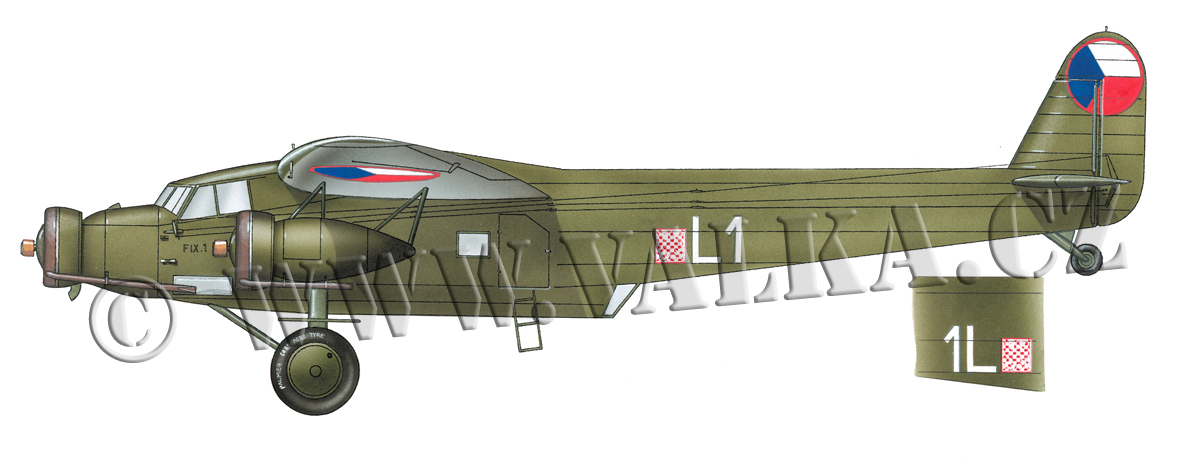
 www.armedconflicts.com
www.armedconflicts.com
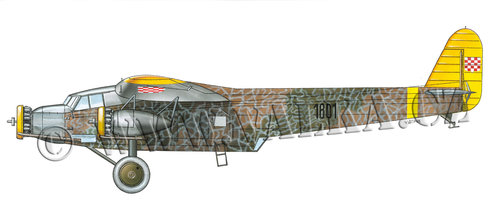

Avia Fokker F-39 : Avia
Avia Fokker F-IX bombardovací letoun DD.MM.1932-DD.06.1934
- Joined
- 11 March 2006
- Messages
- 8,625
- Reaction score
- 3,806
....,but I think maybe it was anther concept ?.
Translation of the attached article via online translator and some corrections:
"In addition to the series of four aircraft for the Air Force, Avia built two more
F-39 export aircraft in the bomber version (maiden flight 2nd of January 1932),
but fitted with the French Gnome-Rhône "Jupiter" engines of 412 kW (560 hp).
They were purchased by the Yugoslav Air Force, for which internal equipment
was also assembled from products of foreign companies, according to
Yugoslavian needs. Production sublicence was also sold to Yugoslavia, however,
no aircraft of that type were built there."
So, no clue to another use of this designation here, I think.
- Joined
- 25 July 2007
- Messages
- 4,299
- Reaction score
- 4,197
... there was a twin engined transport monoplane Project,appeared before F.X,powered by two Wright Cyclone 1820 engines ?,unknown designation for it ?.
That is odd. The R-1820 didn't exist when the Fokker F.X first flew. Perhaps Luchtvaartkennis is getting their Cyclones confused and meant the R-1750 (or even the earlier, 1654 cid Wright P-2 9-cylinder radial)?
- Joined
- 25 July 2007
- Messages
- 4,299
- Reaction score
- 4,197
... there was a Fokker F.VIII transport airplane Project version,but has a sesquiplane configuration, never built.
A quibbling difference ... the 1922 sesquiplane project wasn't an "F.VIII transport airplane Project version". The built F.VIII didn't exist until 1927.
The sesquiplane F.VIII was a variation on the one-off, 1921 F.V convertible monoplane/biplane - intending to re-use the same fuselage design but with different wings.
- Joined
- 25 July 2007
- Messages
- 4,299
- Reaction score
- 4,197
No dear Apophenia,
I am sure it was called F.VIII,but the beginning of this designation was in 1924/25.
Okay. We know for sure that there was a 1922 F.VIII project and that Reinhold Platz launched into the built F.VIII design (as a trimotor) in 1926. No reason to assume that this designation couldn't have been recycled more than once ...
My quibble was with the "F.VIII transport airplane Project version". Possibly I'm being pedantic but, to me, that implied a projected variant of the built F.VIII (or its 1926 design phase).
Aubi
ACCESS: Secret
Fokker 60 was stretched variant of Fokker 50, which in turn was Fokker F27 Friendship with Pratt & Whittney turboprops instead of Rolls-Royce Dart.
- Joined
- 26 May 2006
- Messages
- 34,916
- Reaction score
- 15,790
Fokker 60 was stretched variant of Fokker 50, which in turn was Fokker F27 Friendship with Pratt & Whittney turboprops instead of Rolls-Royce Dart.
Of course I know that dear Aubi,
but that was a Project pre-1945,it was not related to this one at all.
- Joined
- 25 July 2007
- Messages
- 4,299
- Reaction score
- 4,197
... but that was a Project pre-1945,it was not related to this one at all.
The Fokker F.60 project was for a transatlantic airliner, designation based upon 60 passenger payload. Never heard of an .F.63'.
Aubi
ACCESS: Secret
Okay. I assumed it's related to the picture on the cover.
Anyway, i found an interresting books, Fokker Commercial Aircraft: From the F.I. of 1918 up to the Fokker 100 of Today.
F.56 was according to the book a 1935 project of 56-seat mid-wing passenger plane with two decks and four 1000 hp engines. F.60 or F.63 are not mentioned.
Anyway, i found an interresting books, Fokker Commercial Aircraft: From the F.I. of 1918 up to the Fokker 100 of Today.
F.56 was according to the book a 1935 project of 56-seat mid-wing passenger plane with two decks and four 1000 hp engines. F.60 or F.63 are not mentioned.
- Joined
- 26 May 2006
- Messages
- 34,916
- Reaction score
- 15,790
So weird,
the Fokker F.XXXVI Bomber variant,sure it was a Project ?.
the Fokker F.XXXVI Bomber variant,sure it was a Project ?.
Blueprint Fokker F XXXVI: Map | Stadion Books
Soft cover - NV Nederlandsche Vliegtuigenfabriek, Amsterdam, Holland - Condition: Good - 13-11-1934, 132 x 84, good condition, the picture is not included - Blueprint Fokker F XXXVI
www.abebooks.com
Attachments
Last edited:
Hesham.
The book of which the cover is shown was published in 1963 and written
by the late Hugo Hooftman, aviation writer and publisher of Cockpit , a Dutch aviation mag.
( I obtained the book when I was 18 ...ahem )
)
A few captions in de book are incorrect , especially in the chapter abour te Fokker 4-engined designs.
The drawings (or the captions) of the F.XXII and F.XXXVI are wrong. The schetch of the 180 is not the F.180 but ontwerp 180.
The so called F.60 or F.63 are not mentioned in the excellent new book 'The Fokker fours' devoted to all Fokker 4 engined
aircraft constructed and many projected.
The book of which the cover is shown was published in 1963 and written
by the late Hugo Hooftman, aviation writer and publisher of Cockpit , a Dutch aviation mag.
( I obtained the book when I was 18 ...ahem
A few captions in de book are incorrect , especially in the chapter abour te Fokker 4-engined designs.
The drawings (or the captions) of the F.XXII and F.XXXVI are wrong. The schetch of the 180 is not the F.180 but ontwerp 180.
The so called F.60 or F.63 are not mentioned in the excellent new book 'The Fokker fours' devoted to all Fokker 4 engined
aircraft constructed and many projected.
Last edited:
richard B
ACCESS: Secret
- Joined
- 17 August 2006
- Messages
- 343
- Reaction score
- 498
So weird,
the Fokker F.XXXVI Bomber variant,sure it was a Project ?.
Strange : the first print is in German ...
- Joined
- 26 May 2006
- Messages
- 34,916
- Reaction score
- 15,790
OK my dear Lark,
and I just displayed what was mentioned in this book,and for F.60,I will ask in Dutch forum about
it,maybe there was any reliable Info about it and to confirm,also the F.XX Bomber,there was a drawing
to it,maybe in a museum or Fokker company as I know,as F.XXXVI Bomber.
and I just displayed what was mentioned in this book,and for F.60,I will ask in Dutch forum about
it,maybe there was any reliable Info about it and to confirm,also the F.XX Bomber,there was a drawing
to it,maybe in a museum or Fokker company as I know,as F.XXXVI Bomber.
Fokker F.40 also mentioned as F.XL
Planned 1935 variant of the F.36/37 offered by Fokker to the KLM.
Several designs planned under this designation
4-engined civil liner as high- mid- or low wing aircraft for 40 passengers, two tailfins.
A twinboom Burnelli wing type with accomodation in the wing was also on the drawing board.
Offer not taken up by KLM.
Still searching for a good illustration...
Source. Luchtvaartkennis 2/2008/Air Britain Netherlands branch-Fred Gerdessen.
The Fokker Fours , new book by Rob J.M.Mulder.
,
Planned 1935 variant of the F.36/37 offered by Fokker to the KLM.
Several designs planned under this designation
4-engined civil liner as high- mid- or low wing aircraft for 40 passengers, two tailfins.
A twinboom Burnelli wing type with accomodation in the wing was also on the drawing board.
Offer not taken up by KLM.
Still searching for a good illustration...
Source. Luchtvaartkennis 2/2008/Air Britain Netherlands branch-Fred Gerdessen.
The Fokker Fours , new book by Rob J.M.Mulder.
,
- Joined
- 26 May 2006
- Messages
- 34,916
- Reaction score
- 15,790
By the way,
the Fokker Ontwerp 136 was in two variants,the first had a conventional two main wheels and one tailwheel landing gear,the second had a tricycle
and nose wheel,all had a retractable landing gear,and the second variant had a seal nose.
the Fokker Ontwerp 136 was in two variants,the first had a conventional two main wheels and one tailwheel landing gear,the second had a tricycle
and nose wheel,all had a retractable landing gear,and the second variant had a seal nose.
- Joined
- 26 May 2006
- Messages
- 34,916
- Reaction score
- 15,790
What was this airplane or Projects ?,
A five motors Fokker (2,250 hp), two
floors, and able to carry 40 passengers, and a
three-engine (1,260 hp), public transport capable
of carrying 30 passengers.
A five motors Fokker (2,250 hp), two
floors, and able to carry 40 passengers, and a
three-engine (1,260 hp), public transport capable
of carrying 30 passengers.
Attachments
Last edited:
Bazinga
I really should change my personal text
- Joined
- 14 December 2012
- Messages
- 293
- Reaction score
- 406
Hi,
here is a drawings to Fokker F.XXXVII and F.XXIII.
Fokker F.XXXII
Fokker F.XXXVII was een ontwerp project van een aangepaste F.XXXVI met intrekbaar landingsgestel, maar is niet gebouwd.
Attachments
- Joined
- 26 May 2006
- Messages
- 34,916
- Reaction score
- 15,790
Hi,
here is a drawings to Fokker F.XXXVII and F.XXIII.Fokker F.XXXII
Fokker F.XXXVII was een ontwerp project van een aangepaste F.XXXVI met intrekbaar landingsgestel, maar is niet gebouwd.www.fokker-history.com
Drawing No.378501.
- Joined
- 11 March 2012
- Messages
- 3,251
- Reaction score
- 3,179
See the photograph spanning pages 296 and 297 of "Anthony Fokker, the flying dutchman who shaped American Aviation." by Marc Dierikx (Smithstonian Books, Washington, D.C. 2018). ISBN 9781588346162 (eBook) or 1588346153 (hardcover).Hi,
here is a drawings to Fokker F.XXXVII and F.XXIII.Fokker F.XXXII
Fokker F.XXXVII was een ontwerp project van een aangepaste F.XXXVI met intrekbaar landingsgestel, maar is niet gebouwd.www.fokker-history.com
The photo portrays Anthony Fokker explaining the D.XXXVI airliner to Soviet representatives. The airplane was traditional wood and steel structures covered in fabric. Fokker never sold airplanes to the USSR. By the late 1930s, Anthony Fokker personally was unable to keep up with the latest developments in all-metal airplanes, so he shifted away from production and focused his efforts to acting as European sales rep for Douglas (DC-2) and Lockheed (Electra)
Bazinga
I really should change my personal text
- Joined
- 14 December 2012
- Messages
- 293
- Reaction score
- 406
There is actually a really nice dramatized series about Fokker and Plesman (KLM) on dutch public television. I was impressed by the detail of the story and the accuracy of it. https://www.npostart.nl/vliegende-hollanders/AT_2092376 It is of course called de vliegende hollanders or in english, the flying dutchmen (plural). There is a siderole for Koolhoven. It indeed mentions that Fokker failed to swith to metal and instead gained rights selling US planes. He died in Sept 39 after failed sinus operation.See the photograph spanning pages 296 and 297 of "Anthony Fokker, the flying dutchman who shaped American Aviation." by Marc Dierikx (Smithstonian Books, Washington, D.C. 2018). ISBN 9781588346162 (eBook) or 1588346153 (hardcover).Hi,
here is a drawings to Fokker F.XXXVII and F.XXIII.Fokker F.XXXII
Fokker F.XXXVII was een ontwerp project van een aangepaste F.XXXVI met intrekbaar landingsgestel, maar is niet gebouwd.www.fokker-history.com
The photo portrays Anthony Fokker explaining the D.XXXVI airliner to Soviet representatives. The airplane was traditional wood and steel structures covered in fabric. Fokker never sold airplanes to the USSR. By the late 1930s, Anthony Fokker personally was unable to keep up with the latest developments in all-metal airplanes, so he shifted away from production and focused his efforts to acting as European sales rep for Douglas (DC-2) and Lockheed (Electra)
Similar threads
-
Dutch Fokker bomber and fighter projects from the late 30ties
- Started by T-50
- Replies: 212
-
Huff-Daland XHB-1 Cyclops / Atlantic Fokker XHB-2 bombers (1926)
- Started by Stargazer
- Replies: 4
-
-
-
Ilyushin Civil and Military Prototypes & Projects
- Started by hesham
- Replies: 16

